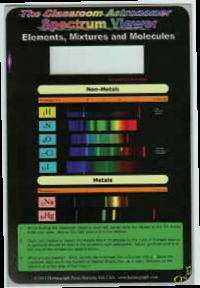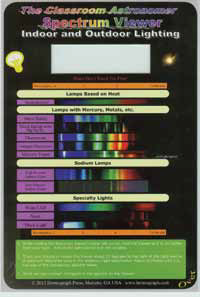The Classroom Astronomer Spectrum Viewers: Elements, Mixtures, and Molecules; Indoor and Outdoor Lighting
By Ken Roberts
Posted on 2011-11-25
The Classroom Astronomer Spectrum Viewers provide a handy, convenient classroom tool for identifying and learning about various spectra. The Viewers are rectangles of stiff, glossy cardboard (about 8.5”× 5.5”) with a piece of spectrum film securely embedded in their tops. They seem very sturdy, and I expect they will stand up to years of student use. Easy-to-understand directions are printed on the bottom of the Viewers. The text is simple and clearly printed so that it is easy to read, which makes the Viewers easy to use. Printed on the cards are examples of continuous, bright- and darkline spectra to which students can refer. On the Elements, Mixtures, and Molecules model, spectra for 15 different gasses are included. On the Indoor and Outdoor Lighting model, spectra for 11 different types of lighting are included. As a bonus, the back side of the Indoor and Outdoor Lighting model provides general notes about lighting and spectra, and characteristics of common light sources. This side also has a student activity that explains how students can check the energy efficiency of their neighborhood by using the Viewer to identify the type of bulbs used. This extra information and activity are a nice supplement and turn a classroom “tool” into a classroom “resource.” One of the biggest challenges that I have faced when using other spectrum viewers is that the students never know what they are supposed to see and struggle to hold their viewers at the correct angle to the light source. The Classroom Astronomer Spectrum Viewers alleviate both of these issues and provide a simple but effective classroom instruction tool. I find these viewers to be much more useful and easier to use than models I have used in the past. The fact that they are flat also makes a classroom set much easier to store than the larger, plastic, wedge-style viewers that many teachers may have encountered.
Disclaimer: The views expressed in this blog post are those of the author(s) and do not necessarily reflect the official position of the National Science Teaching Association (NSTA).




